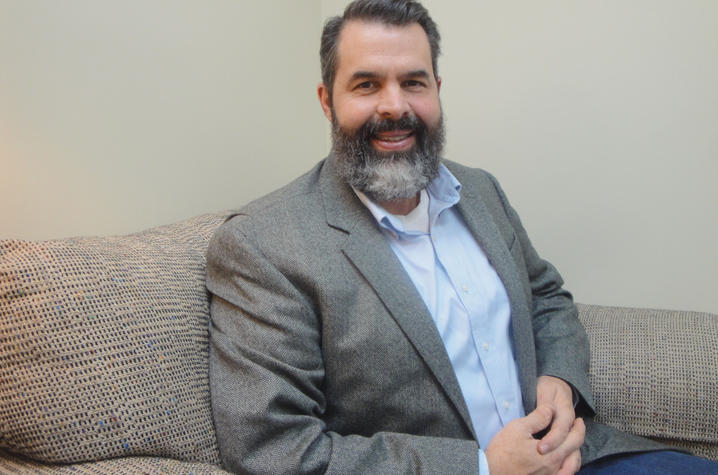Native Appalachian Strives to Improve Rural Health
LEXINGTON, Ky. (Jan. 27, 2016) — With picturesque mountains, moderate weather, a rich history and a culture filled with art and music, Appalachia is a region many are proud to call home.
Unfortunately, Appalachia is also home to the highest rates of smoking and smoking-related diseases – such as lung cancer and chronic obstructive pulmonary disease (COPD) – in the nation.
Brady Reynolds works in the University of Kentucky College of Medicine's Department of Behavioral Science. With a deep personal connection to Appalachia and a love for the region, Reynolds works in Eastern Kentucky to help find new strategies to reduce smoking rates and improve the health of the community.
Reynolds grew up on a farm in rural Virginia. The Appalachian influence in his family permeated his childhood, listening to his father play banjo in a bluegrass band and developing a deep appreciation for his roots.
When he graduated high school, he stayed in Appalachia to continue his education, earning a bachelor's degree in psychology from James Madison University in Harrisonburg, Va., and a doctorate in Lifespan Developmental Psychology from West Virginia University in Morgantown. After working in the field for several years, Reynolds joined the faculty at UK to invest himself in addressing Appalachian health issues.
“When I started doing smoking-related research, it was a natural evolution for me to focus my work in rural Appalachia,” Reynolds said.
Because of the myriad health issues smokers experience as they age and high rates of smoking, Appalachian communities face many health problems. For researchers looking for new strategies to reduce smoking rates and improve health in the community, the region is a fertile testing ground.
The reasons for the high smoking rates in Appalachian communities are well known but difficult to combat nonetheless. Rural Appalachian communities traditionally relied on tobacco production, had lower educational attainment and higher poverty rates. All of these factors associate with increased smoking rates.
“Working to reduce use of tobacco in Appalachia is complex for many of the same reasons,” Reynolds said. “Additionally, most of the people in this region are resistant to accepting strategies or interventions that originate from outside the Appalachian community. Also, limited access to information and services further complicates efforts to reduce smoking.”
Many of the rules that apply to community smoking rates simply do not apply in rural Appalachia.
Adolescents outside Appalachian communities have a higher risk to start smoking if they score higher for psychological measures of impulsive behavior. In rural Appalachia, Reynolds was surprised to find in a 2015 study this did not hold true for Appalachian adolescents. Instead, he found a more accurate predictor of adolescent smoking was how many friends and family members smoked.
In other words, Reynolds found the sheer number of significant others who smoke could override an adolescent’s better judgment.
Also, pregnant women living in Appalachia are more likely to smoke, with as many as one in four women smoking while pregnant. Children born to mothers who smoked while pregnant are themselves more likely to smoke in addition to being at greater risk for a litany of other health pitfalls like obesity, impaired reading, and attention deficit hyperactivity disorder (ADHD).
An end result is a cycle of health problems and poverty.
In order to help people in rural Appalachia quit smoking and take charge over their health, Reynolds began working with local communities in the countryside to experiment with new smoking cessation programs. Reynolds currently operates near Morehead, Ky., in the Appalachian Health Research Center, where he and his team are testing a new program to help residents quit smoking.
Current smoking cessation programs often rely on counseling, meaning participants travel to a health center for their regimen. This approach is unfortunately less successful in rural Appalachia because residents may live in isolated communities with limited access to health centers.
Reynolds believes another approach known as contingency management (CM) already utilized by mental health and substance abuse professionals could help people quit smoking. CM programs tested outside of Appalachia show promise, and Reynolds hopes a web-based program could work when other approaches have not.
CM programs use a reward-based system to achieve results. As participants modify their behavior by cutting back on the number of cigarettes they smoke, they receive monetary compensation or vouchers for rewards. The more progress the participants make, the more CM program rewards them for their effort. Such programs already have proven track records with other addictive drug, like opiates and cocaine.
Reynolds focuses most of his efforts with testing the CM program on adolescent and pregnant smokers, both of whom have difficulty traveling to health centers for counseling and could potentially benefit the most from the new strategy. Unfortunately, even the web-based CM program faces challenges. Because rural Appalachia has limited access to broadband internet, more than 95 percent of Reynolds’ participants needed loaner internet equipment for the studies.
Each day, participants would log on to the web-based program called Mōtiv8 and use a webcam to record videos of measuring carbon monoxide levels in their blood with a breath test. Participants would save their videos to the server along with their carbon monoxide data so Reynolds and his team could assess how well the program worked.
Each study was small, but the results showed promise.
Roughly one-third of pregnant mothers stopped smoking completely, and adolescent cigarette use halved. Furthermore, six weeks after the studies concluded, most participants did not relapse. Reynolds currently plans to increase the number of participants in future studies to see if the observed benefits of the CM program continue to hold. If the CM program still appears effective, then his team can focus on making the regimen economically feasible for the larger population.
“Smoking during pregnancy is the leading cause of low birth weight and preterm birth, and these infants often spend substantial time in neonatal intensive care units (NICUs), which can be very costly for hospitals and insurers,” Reynolds said. “If we find our smoking cessation programs reduce preterm birth (and the associated NICU costs), then we can start making the argument to stakeholders for implementing the programs on a larger scale.”
Reynolds’ research is currently supported in part by the UK Markey Cancer Center, National Cancer Institute and Foundation for a Healthy Kentucky Endowed Chair in Rural Health Policy.
MEDIA CONTACT: Allison Perry, (859) 323-2399 or allison.perry@uky.edu






